What is Malwarebytes?
Malwarebytes is a California-based company that has been actively developing software programs that look for malware infections on computers. The company has been in business for more than 15 years now. Malwarebytes 4.2.1 is out in the market for quite sometime now, and the company claims it to be much smarter than traditional antiviruses. Interestingly, Malwarebytes can run alongside any other antivirus software that you have. The company offers versions for PC, Mac, iOS, Android, and Chromebook.
Is Malwarebytes really good as claimed by the company? We are going to find that out this is review. But before we start with the complete review, let’s quickly take a look at the pros and cons of the program.
The Pros and Cons of Malwarebytes
Nothing in this world is can be perfect. Malwarebytes is definitely not perfect. There are strengths and weaknesses that you should learn about before you decide to purchase a subscription. Here is a quick list of the pros and cons of Malwarebytes:
The Pros
- Easy to use interface.
- Compatible with antivirus programs.
- Cheap yearly subscription rates.
- Offers powerful anti-exploit modules.
- Highly rated by AV-Test.
- An always-free option is available.
The Cons
- Gives false blockages.
- Detection rates have improved only recently.
- Not many independent testing results are found.
Okay, now that you have a sneak peek into the strengths and weaknesses of Malwarebytes, it is about time that I walk you through the detailed review of the program.
Ready?
Specialty of Malwarebytes
Starting version 4.0, Malwarebytes started claiming that it was smarter than the regular antivirus programs, because it deploys multiple layers of technology that include behavior matching, anomaly detection, and application hardening.
Version 4.0 onwards, Malwarebytes introduced its brand-new Katana engine that has an improved technique for monitoring behavior so that the very latest threats can be blocked immediately. It also introduced enhanced zero-hour detection, and rapid publication of threat definitions.
The newly designed interface is now simpler than ever before and provides a lot more valuable information to the users.
According to the company, the latest version of Malwarebytes is the most lightweight and the fastest version ever created.
Pricing Structure of Malwarebytes
I will like to clarify that I am focusing only on the version available for home users. This segment of the review will not touch over the enterprise solution that Malwarebytes offers.
Unlike many popular antiviruses and anti-malware programs, the company offers two things – a completely free version (with no real-time protection), and a 14-day trial of the premium version. Once the trial period is over, the premium trial will roll back to the free version that you can keep using for as long as you want, and you don’t have to pay a dime for it.
Though real-time protection will be absent from the free edition, you still get rootkit detection, on-demand spyware and malware scan.
If you want to purchase the premium version of the program for a single computer for a year, it will cost you $40. If you extend the license to three devices, the license will cost 60 USD a year.
However, in case you decide to purchase the program for two years, you need to pay $70 for a single device while the price for a three-device license for two years will be $105. That’s a whopping 25% discount!
I will have to accept that it is quite cheap compared to many popular antiviruses you can find today. However, there are many antivirus programs that will offer dramatic discounts for the first year of subscription. Unfortunately, the price at renewal increases significantly.
Malwarebytes Setup and Ease of Use
The setup and installation process of Malwarebytes is very simple. All you have to do is download the free version and enjoy a 14-day premium version trial. The first thing that you notice after double-clicking the downloaded installer file is the choice of selecting between your home computer and your work computer.
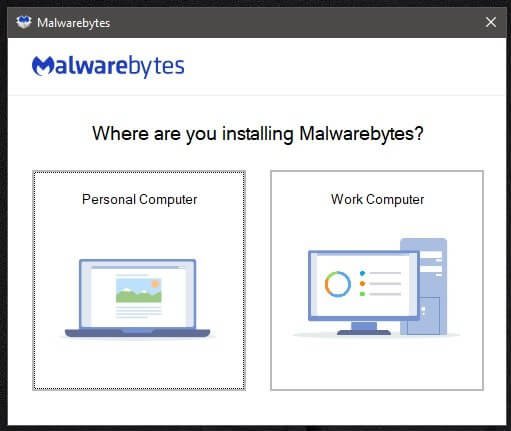
Once you select the option of your choice, you will get the installation prompt with a link for advanced options. The advanced option will allow you to set the installation folder and path. You can also select not to create a desktop shortcut.

If you click the install button, the application will ask whether you want to install the Browser Guard for free or not. It is a choice and you will have the option of skipping it. Once you choose whatever you prefer, the installation process will begin immediately. The installation takes about a minute or so.
Once the installation is completed, you will get the welcome screen with a single button saying ‘Get Started.’

Once you click on the Get Started button, you will first be asked to buy a license or proceed without a license. If you want to enjoy the free trial, select the option of proceeding with a license. At that point the application will tell you that you are on a 14-day trial.
You may or may not provide an email address at this point. By providing your email ID, you will give explicit permission to Malwarebytes to send promotional emails to you.
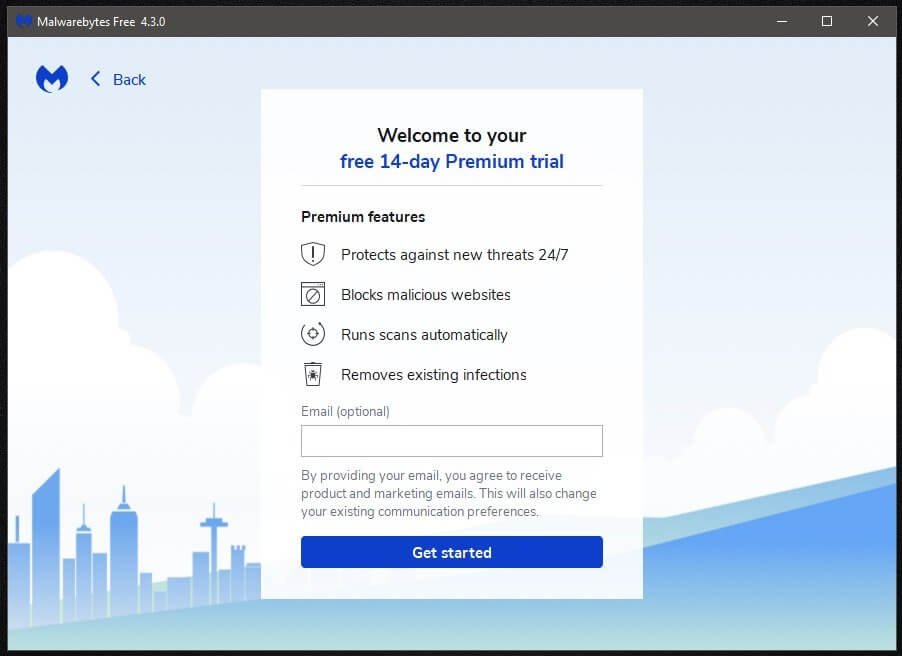
Whether or not to provide your email ID is a choice. Make a wise call!
At this screen if you click on the Get Started button, you will see the actual application screen that will highlight whether you have a premium version or a free trial of the premium version. You will also notice the list of real-time protections that are enabled by default.
The screen will also give you the history detections and the ability to launch a quick scan:
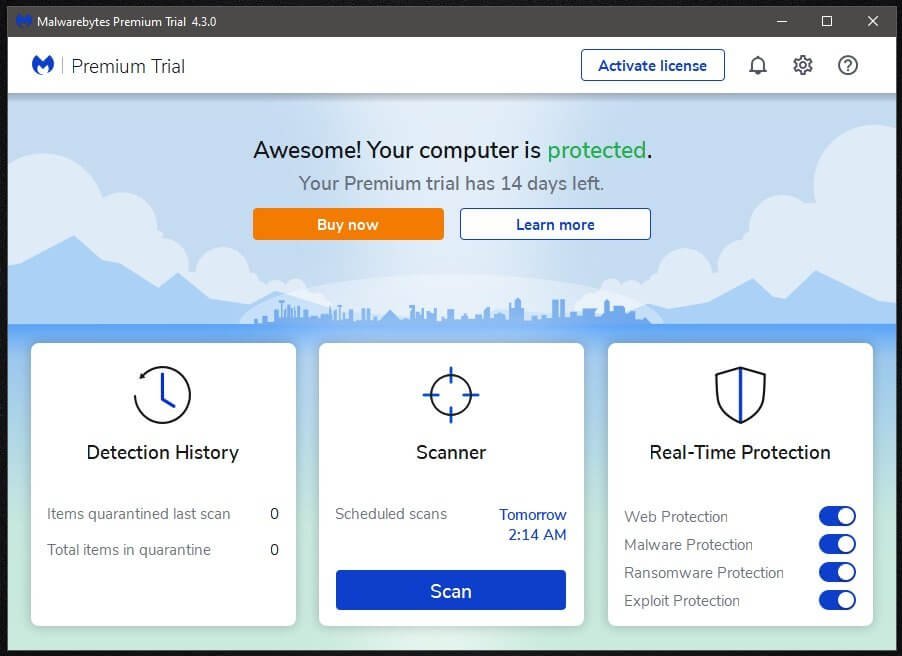
Hitting the scan button will start the scan immediately. You can see the scan duration, number of items scanned, and the number of malware or possible malware detected by Malwarebytes.

Once the scan is complete, it will give you a taskbar notification and the scan window will immediately show the list of malwares and potentially unwanted programs. It also shows a complete count of the total number of flagged items, total scan time, and the total number of scanned items. You will get the option of saving the results, quarantine the flagged items, or close the results window.

You can quarantine all the options you see on the results page or you can selectively quarantine the ones you know for sure are malwares.
However, do remember that Malwarebytes has a history of false blockages. If quarantining a few things are breaking your system or rendering a few applications unusable, you need to de-quarantine them.
Since I wanted to see what impact quarantining the flagged items would have on the system, I quarantined all of the results.
Quarantining the results showed a notification that all files have been removed successfully and that a system restart was required. I also noted that once I clicked on the Quarantine button, Google Chrome browser closed automatically.
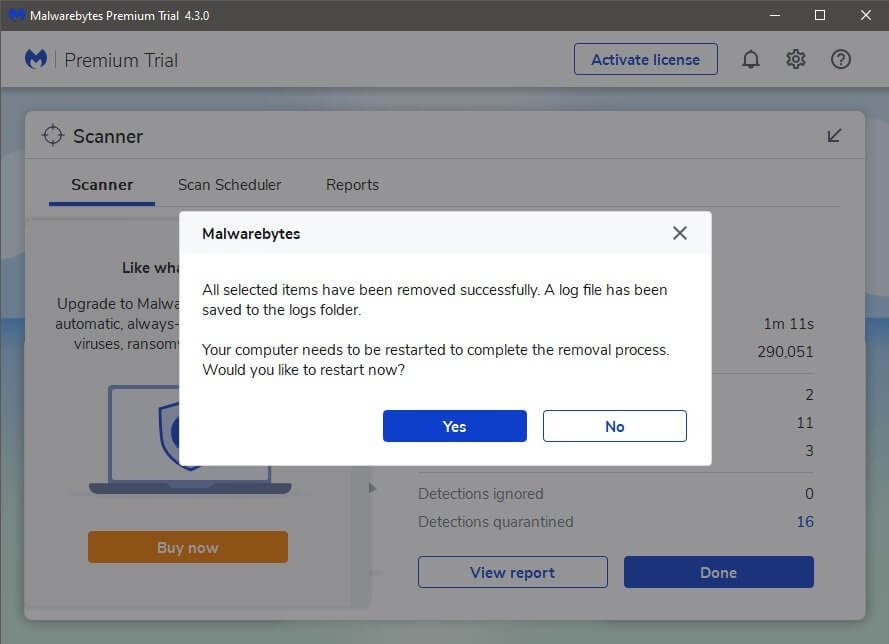
I restarted the computer with an apprehension that the system would break. The reason for this fear was than my Kaspersky Total Security program did not flag any of those. Also, it is one of the top security products as per AV-Test. So, a question that naturally popped up was ‘who was right – Malwarebytes or Kaspersky?’
Once the computer restarted, Malwarebytes came into action immediately and represented a threat scan summary report.
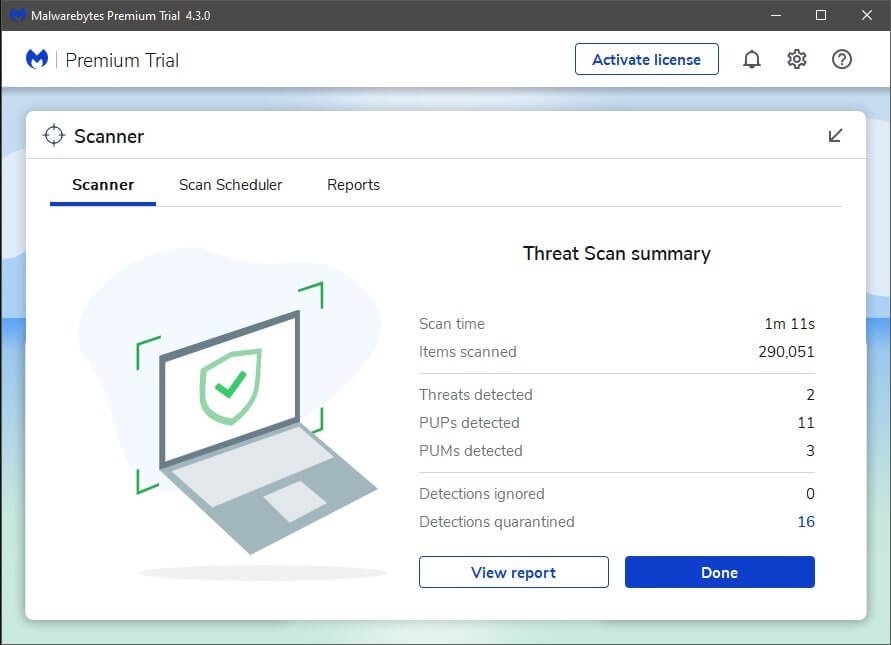
The threat report showed that there were a total of 11 PUPs or potentially unwanted programs, three PUMs or potentially unwanted modification in the registry values of Windows, and two threats.
Clicking on the view report button showed the actions taken by Malwarebytes. Some of the options were replaced by their original values while some were completely quarantined.

I did not see any issues with the PC performance. To check for issues that my inexperience eye would usually skip, I ran a full system scan using Kaspersky. It took a while but no threats emerged.
I went back to check the options that were replaced by Malwarebytes, and found that those were small changes and optimizations I made to customize Windows the way I wanted. Some of those were optimizations carried out by optimization programs.
So, the PUMs and PUPs weren’t really threating! Malwarebytes flagged them simply because the behavior was similar to what Malwares do. I won’t say that’s an awful thing! It is always better to stay secure.
What I understood by using Malwarebytes and Kaspersky together is that Malwarebytes will warn you even when it detects slightest of changes instead of deciding things for you. Kaspersky, on the other hand, is fully aware that such changes are not made by malwares or ransomware or other online threats, and hence, didn’t flag anything!
If you know that certain flagged items are not malwares, you can make Malwarebytes to ignore them and put them in the Allow list. To do that, when you run a scan and potential unwanted modifications or potentially unwanted programs are found, uncheck them before clicking the Quarantine button.
Once you uncheck them and click the Quarantine button, you will find three options – Cancel, Always Ignore, and Ignore Once.
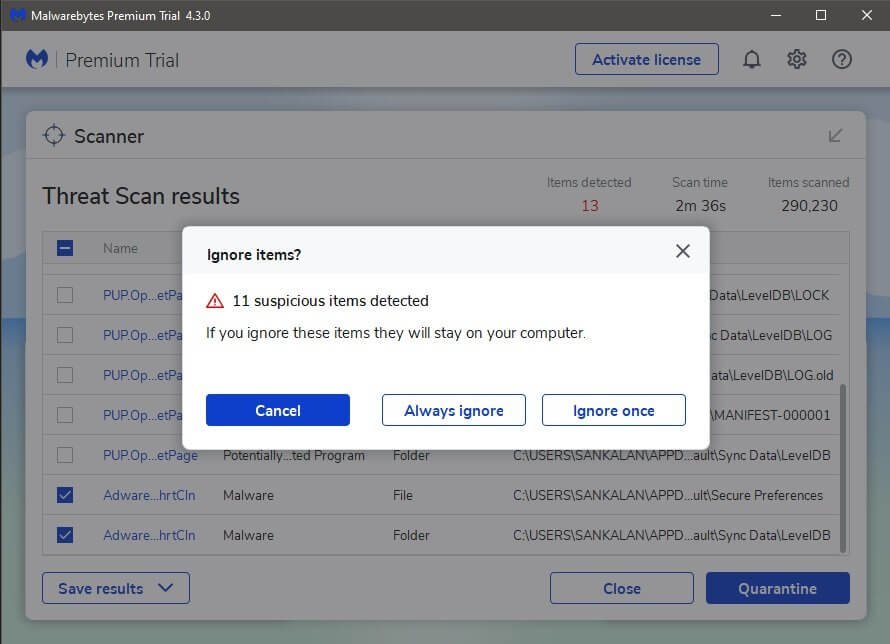
Click on the Always ignore option and the items will be added to your Allow list. The next time you run a scan or the next time an automatic scan runs, Malwarebytes will ignore those items. If you click Ignore once, Malwarebytes will flag them again during the next scan.
You can access the settings of Malwarebytes by clicking on the little cog icon you see on the top righthand corner.

On this tab you will find the Scan options where you can enable rootkit scan, and even ask Malwarebytes to scan inside archives. Several options will be activated by default. You have to enable the other options manually.
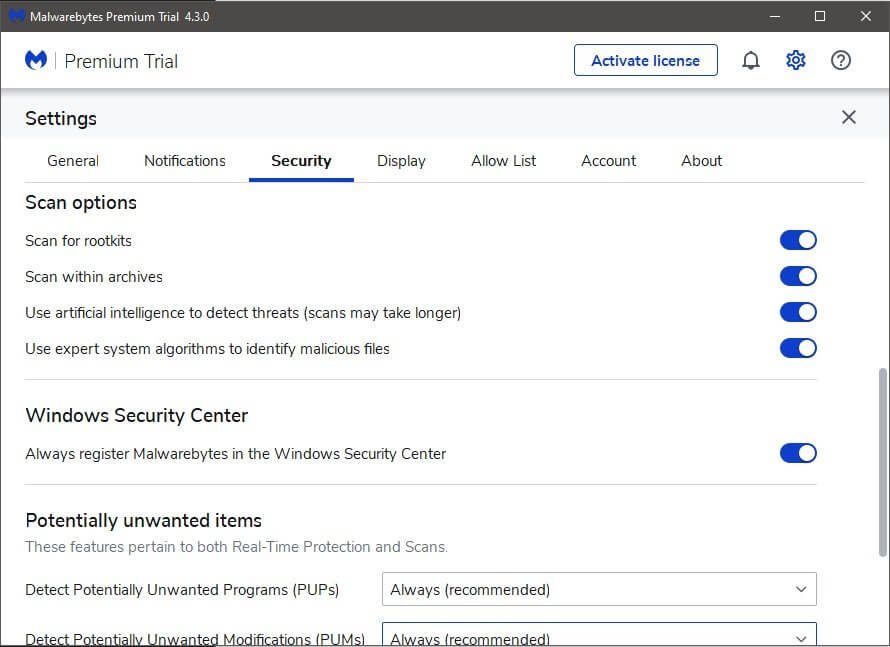
The items that you ask Malwarebytes to ignore will show up on the Allow List tab. The Display tab is where you can change the theme of the Malwarebytes interface. You can enable dark mode from there.
The small question icon you see next to the cog icon on the top righthand corner gives you access to Malwarebytes customer support, user guides, support tools etc.
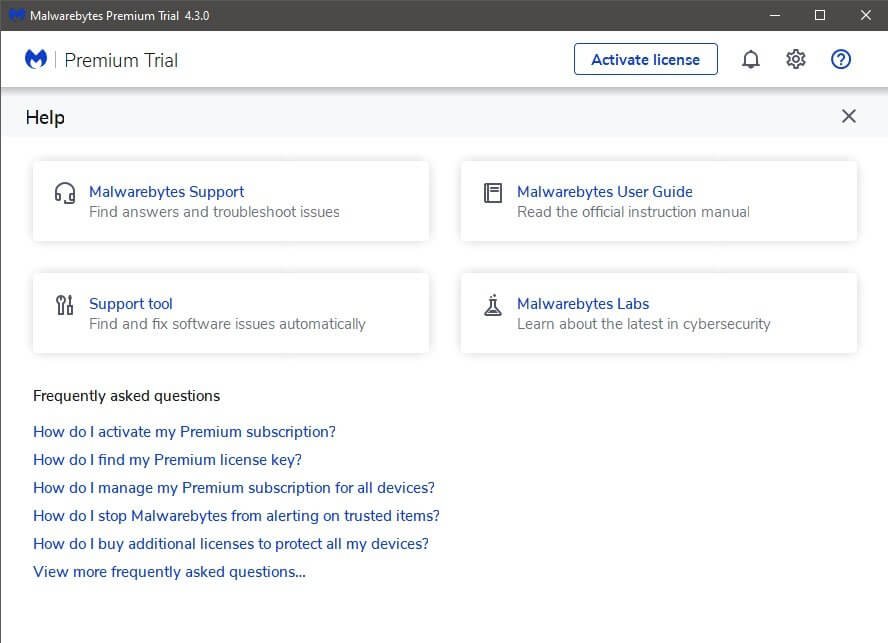
The overall interface of Malwarebytes has seen a complete overhaul since version 4.0. The latest version is 4.3.0.98. I don’t think there will be any significant UI changes for quite some time, because the latest UI design seems to be working pretty well with people.
Malwarebytes Performance and Independent Test Results
Okay, using Malwarebytes was not difficult. In fact, it is one of the easiest and clutter-free interfaces you can find among security applications. But, that’s not enough, is it? Malwarebytes has a purpose, and how well does it fulfill the purpose? Let’s find out!
Impact on Computer Storage Space
The first thing that you need to check is the impact a program makes on your computer. If it is eating up a lot of your system resources and making the system sluggish, you should dump that program right away.
Here is what Malwarebytes consumes:
Disk Space: 222 MB (contains 700 files and 40 folders in the installation folder).

That’s perfectly acceptable. Compare this with 562 MB consumed by Kaspersky, which is a full-blown security suite unlike Malwarebytes. So, the space occupied by Kaspersky is quite justified.
Okay, disk space is low, but does that mean that the impact on system is low? I decided to find out what happens when Malwarebytes is idle and compare its metric with Malwarebytes in action. Here are my findings:
System Impact – Idle State
In the idle state, there are two instances of Malwarebytes that run on your computer – the tray application and Malwarebytes service.
Here is what the tray application consumes:

Here is what the Malwarebytes service consumes:

Since Malwarebytes keeps running in the background silently and keeps protecting your computer, it uses some system resources. It consumes 0.1% of CPU, 0.1 Mbps of disk I/O, and 220.0 MB RAM. That’s negligible for the system configuration that I have. Here is my system configuration:
CPU: Intel Core i5-8500 CPU with 6 cores.
Total RAM: 16 GB.
Total Disk Space: 250 GB SSD where the OS sits along with all installed applications and 1 TB HDD to keep all my documents and files (not counting the external SSD storages that I have).
With that configuration, whatever Malwarebytes is consuming is negligible. However, if your system is underpowered, things can change for you.
System Impact – Active State
When the application starts monitoring the computer and starts active scanning, resource usage increases. This is what I found for Malwarebytes tray application:

There is a bump in both CPU usage and RAM usage.
This is what happens for Malwarebytes services:

The power usage and power usage trend are Very High and Moderate, respectively. However, the power usage keeps fluctuating from very low to very high. This happens for every application that is in active use.
While Malwarebytes was in action, there was no significant drop in computer performance. I could simultaneously use Google Chrome – the biggest memory hog I have ever seen, Microsoft Office, Microsoft Paint (yes, I use Paint (lamo)), Adobe Photoshop, Microsoft Excel, File Manager, and not to forget – Kaspersky was running in the background.
On Chrome, I was playing YouTube and there were 16 tabs open! With all these applications running at once, there was not sluggishness at all while using them. However, I did notice that there was some slowdown when it came to launching the applications.
Some of that may be attribute to the moderately powerful computer that I have. In case your system is a low-end one, you may experience more performance issues.
Overall, for moderately powerful systems, Malwarebytes is a lightweight application. From what I can say from my previous encounters with Malwarebytes, the application is now vastly improved, and indeed the most lightweight version ever.
Malware Tracking Performance
Malware tracking is the core business of Malwarebytes. So technically, this is where it should be performing the best.
I am no security geek, which means that I am definitely not in a position to test everything. That’s the reason why I fall on to independent tests. This is where AV-Test comes into picture. It is an independent security audit firm that audits and finds out how different security programs perform.
Looking at the historical performance data, Malwarebytes hasn’t been great. However, in the last two tests performed in September and October 2020, the results were good.
When it comes to offering protection from 0-day malware attacks that include email and web threats, the application scored a perfect 100% in September and 99.4% in October, which is above the industry average of 98.8%.
When it comes to detection of widespread malware over the past four weeks, Malwarebytes scored an impressive 100% in both September and October tests. However, the industry average was also 100%. So, Malwarebytes definitely becomes one of the finest in the industry.
Here is a screenshot of the test results:

When it comes to system impact, Malwarebytes again performed excellent with a perfect 6 on 6 score.

However, when it came to false warnings or blockages, Malwarebytes lagged behind the industry average leading to a score of 5 out of 6. Here is the screenshot:

It is needless to say that such false alarms can be disastrous. You may accidentally block or delete something that can break your system.
It is now December 2020, and things might have improved further. We have to wait and watch.
But just because the last two tests results were impressive, it doesn’t mean that Malwarebytes has been historically great! Here is the historical data that you should check:
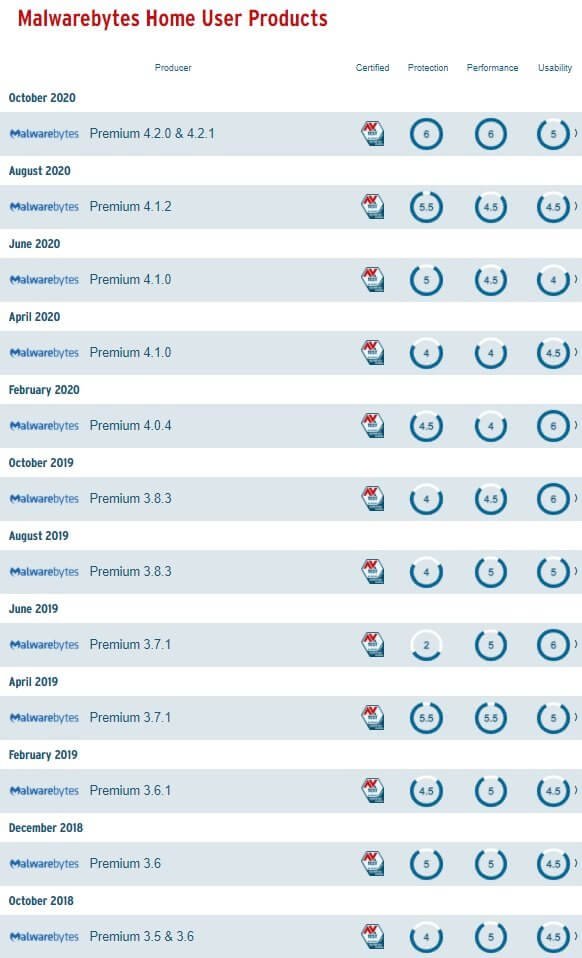
The previous test results were totally not impressive. However, Malwarebytes has shown a steady improvement and I hope that over the coming years, it becomes one of the top security products that your money can purchase.
Extras (Present or Absent)
Security suites like Kaspersky, Norton, TotalAV, etc. throw in a lot of extras to work with. For instance, Kaspersky has a password manager, a parental control feature, VPN, PC optimization, and more.
Malwarebytes will not offer you those things. It is a no-frills malware and ransomware protection application! That’s it! There is nothing more, nothing less!
What you do get is a nice File Manager integration that will allow you to perform a scan by right-clicking on a file or folder (or a zip archive). You can even do that for an entire drive.

However, if you have already initiated a scan or an automatic scan is running in the background, you cannot start a simultaneous scan. This is one feature that I expect every security application to have. But since that feature is absent, I made peace with whatever is available.
Verdict – Do I Recommend It?
I will not recommend using Malwarebytes as the only security application on your computer or device. You should have a complete antivirus program working together. Occasionally, Malwarebytes will protect you from ransomware and malware, however, it is not a complete replacement of a full antivirus security suite as advertised on the homepage of Malwarebytes website.
Combined with an antivirus, Malwarebytes can be an effective tool to keep your computer and compatible devices safe. If you already have a paid subscription of top-rated antivirus program, you need not purchase the premium version of Malwarebytes. The free version should be good enough!

